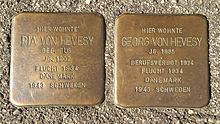George de Hevesy
George de Hevesy | |
|---|---|
University of Freiburg | |
| Known for | |
| Spouse |
Pia Riis (m. 1924) |
| Children | 4 |
| Parents |
|
| Awards | |
| Doctoral advisor | Georg Franz Julius Meyer |
| Other academic advisors | Fritz Haber Ernest Rutherford |
| Doctoral students | Rolf Hosemann Johann Böhm |
| Other notable students | Erika Cremer (postdoc) |
George Charles de Hevesy (born György Bischitz; Hungarian: Hevesy György Károly; German: Georg Karl von Hevesy; 1 August 1885 – 5 July 1966) was a Hungarian radiochemist and Nobel Prize in Chemistry laureate, recognized in 1943 for his key role in the development of radioactive tracers to study chemical processes such as in the metabolism of animals. He also co-discovered the element hafnium.[1][2][3][4][5][6]
Biography
Early years
Hevesy György was born in
De Hevesy began his studies in chemistry at the
Research
In 1922, de Hevesy co-discovered (with
Supported financially by the
In 1924, Hevesy returned to Freiburg as Professor of Physical Chemistry. In 1930, he went to
World War II and beyond

Prior to the onset of World War II, Max von Laue and James Franck had sent their gold Nobel Prize medals to Denmark to keep them from being confiscated by the Nazis. After the Nazi invasion of Denmark this placed them in danger; it was illegal at the time to send gold out of Germany, and were it discovered that Laue and Franck had done so, they could have faced prosecution. To prevent this, de Hevesy concealed the medals by dissolving them in aqua regia and placing the resulting solution on a shelf in his laboratory at the Niels Bohr Institute in Copenhagen. After the war, he returned to find the solution undisturbed and precipitated the gold out of the acid. The Nobel Society then recast the medals using the recovered gold and returned them to the two laureates.[14][15]
By 1943, Copenhagen was no longer safe for a Jewish scientist and de Hevesy fled to Sweden, where he worked at the
While in Stockholm, de Hevesy received the Nobel Prize in chemistry. He was later inducted into the
Family life and death

De Hevesy married Pia Riis in 1924. They had one son and three daughters together, one of whom (Eugenie) married a grandson of the Swedish Nobel laureate
On 10 May 2005 the Hevesy Laboratory
See also
- August Krogh
- List of Jewish Nobel laureates
- Johanna Bischitz de Heves
- 10444 de Hevesy
- Hevesy (crater)
- The Martians (scientists)
- Hungarian Nobel Prize winners
References
- ^ S2CID 122095945.
- S2CID 6640231.
- PMID 4870858.
- PMID 4865432.
- PMID 14184278.
- ^ Weintraub, B. (April 2005), "George de Hevesy: Hafnium and Radioactive Traces; Chemistry", Bull. Isr. Chem. Soc. (18): 41–43
- ^ ISBN 978-0-85274-555-7
- ^ "George de Hevesy, Nobel Prize in Chemistry 1943". geni_family_tree. August 1885.
- ISBN 9780615573106, retrieved 6 June 2023
- ^ Norrby, Erling (2013), Nobel Prizes and Nature's Surprises
- PMID 395289.
- PMID 16743235.
- ^ "The Nobel Prize in Chemistry 1943". NobelPrize.org.
- ^ Hevesy, George (1962), Adventures in radioisotope research, vol. 1, New York: Pergamon press, p. 27
- ^ Birgitta Lemmel (2006). "The Nobel Prize Medals and the Medal for the Prize in Economics". The Nobel Foundation.
- ^ Scripps Log obituaries, http://scilib.ucsd.edu/sio/biogr/ScrippsLogObits.pdf Archived 21 October 2020 at the Wayback Machine
- PMID 13714019
- ^ Hevesy Laboratory
External links
 Media related to George de Hevesy at Wikimedia Commons
Media related to George de Hevesy at Wikimedia Commons- George de Hevesy on Nobelprize.org including the Nobel Lecture on 12 December 1944 Some Applications of Isotopic Indicators
- Annotated bibliography for George de Hevesy from the Alsos Digital Library for Nuclear Issues
- Works by or about George de Hevesy at Internet Archive

